This marks the start of an occasional series within The Real Coed Y Brenin in which I'll take a look at some of the various species that make up the forest and examine how well, or not, they have done in Old Meirionydd, in a temperate, somewhat wet environment.
above: Forestry Commission planting map showing the Douglas Fir (DF) marking the southern edge of Coed Y Brenin, bordered by the Afon Mawddach. Dates here begin in 1925 but other sources, including a plaque on a monument in the forest resembling a small, stone Dalek, give alternative dates ranging from 1922-24.
An examination of the first planting maps and the description of the Coed Y Brenin Arboretum shows very clearly the great number of different tree species that were planted here, at least to begin with. This early design reflects a serious, scientific endeavour, to trial a variety of tree species in a variety of situations with the aim of building up knowledge for application in other districts. However, the approach was of course limited by the available knowledge at the time and existing examples of forest development and management. On top of this were cultural constraints, attitudes towards the natural world, plants and animals.
At the beginnings of the twentieth century, land was still seen very much as something to be tamed and ordered for it to become “productive”. Improvement and modernisation of farming ran along the lines of dividing up the landscape with fences and walls, drainage and monocultures of improved species, soon to be followed by artificial fertilisers, biocides and mechanisation. Forestry was to follow a similar pattern.
Again, reflecting the then current culture and attitudes, the tree species that made up Coed Y Brenin were all exotics and mostly conifers; of the score or so broadleaves, no native trees were included. With a few exceptions, which I'll deal with later, the species were planted in monocultures but in that early, experimental mode, the compartments were further subdivided to create relatively small coupes of each species, rather than the huge swathes of monoculture that were to come later.
above: not easy to capture the size and grandeur of the huge trees in this stand but the figures give an idea.
The first trees to be planted here, in 1924, were Douglas fir (Pseudotsuga menziesii) which aren't actually firs at all and are placed in the pine family. David Douglas, a Scottish botanist and collector reported the nature and potential of the species, hence the name but a rival naturalist, Archibald Menzies, first documented the species on Vancouver Island in 1791, hence the Latin name.
Coed Y Brenin's Douglas Fir which mark the southern end of the forest, are now reaching their first century and topping 100 feet (30 metres). The trees original North American locations are a much colder and drier environment than once wet Cymru. Here they displayed all the vigour we would expect of an exotic, deprived of its natural pests and predators. In the mild climate and high rainfall they grew fast and are now well beyond what would be considered their commercial maturity. The main stands were also thinned at least twice, meaning they were given plenty of room to grow.
above: The King, the tallest of them all and the first to top 100 feet in height. Again, difficult to capture the size. I tried to get a tourist to stand by it but I think I accidentally frightened him and he ran away, leaving his juice bottle to give an idea of scale. Of course I recycled it later…
By the 1980s, the Forestry Commission was unsure what to do with them; there was rumoured to be a million pounds worth of timber in them but they were too large for most mills to handle and liked by visitors for their grandeur. As usual for the Forestry Commission, they did nothing, leaving it to someone further down the timeline to deal with.
above: another view of the King. another view of The King. Douglas self-prune as they grow, hgradually shedding their lower branches to leave beautifully clean, tall trunks. You wouldn’t want to be underneath when one of these branches falls off- they are big, heavy and falling 60 feet or so...
The odd tree started to blow down here and there some thirty years ago, having reached about the maximum height that their root systems could support in the thin soils; this is very visible when they do fall, the stumps revealing an often very large diameter root pan but so thin! For a while the Commission just sent a gang in with chainsaws and tractor to clear the odd fallen tree but this was an expensive operation for just one or two trees a year.
above: Lyn standing by a wind thrown Douglas Fir. Note how thin the root pan is. The shallow soils, often over bedrock, mean no major anchoring roots develop.
Its worth pointing out that if you cut off the trunk of a fallen tree with a large or heavy root pan, the cut stump and root pan will usually fall back into place; this can give a deceptive appearance in that unless you know the tree blew over, it can like it was felled. Its also extremely dangerous unless you know what you are doing- deciding where to make the first cut and whether to cut from the bottom or the top requires considerable experience. If you get it wrong at the least you will find your saw stuck as the cut closes up and at worst you'll be taken by surprise as the cut stump begins to tip back into its hole, dragging the tree, your saw and you along with it.
above: the same fallen tree from a different angle, emphasising the huge spread of the root pan and boggling some mountain bikers. Another wind blown Douglas is in the foreground, probably thrown down in the same gust. Local woodsman, Eric, is the wizard responsible for safely clearing these immense trees.
Some of these Douglas actually snapped, part way up the trunk. When I consider how much force would be required for, say, a giant to snap a trunk that was say six feet (1.8m) across over her or his knee, it boggles me!
Its also worth pointing out that a tree will often snap and fall in the opposite direction to that of the wind, which sounds a bit mad at first. So in a coupe that has suffered following a severe storm, it is not uncommon to find most of the trees uprooted and lying with the wind but those that have snapped pointing the other way. This seems to be because the trees will bend considerably given a powerful gust then break on the recoil.
above: Douglas Fir stump. Stumps can provide ideal spots for birds to pause and deposit their nutrient wrapped seed of bilberry or bramble but in this case, conifers, including young Douglas Fir, have take advantage of the site.
The Forestry Commission's next approach with the Douglas Fir was to try selectively felling a group of trees, concentrating their operation in one area but again, cost was a big factor and opening out larger gaps threatened the remaining trees. Since then, no further operations have happened, other to clear fallen trees where they lie on footpaths, sometimes not even collecting the timber.
Now Cyfoeth Naturiol Cymru (Natural Resources Wales), have taken over the management but have had very little time or energy to do anything given the difficulty of the first four or five years or so of trying to amalgamate three quite different and fiercely independent organisations into one (the Forestry Commission Wales, the Environment Agency Wales and the Countryside Council for Wales, all with their own idea of how to do it!). Since then, they only had a year or so to start actual management of Coed Y Brenin before the much greater pressures of dealing with the phytophthora viruses and clear felling hundreds of thousands of infected larch devoured pretty much all their energy and attention
above: this stump of a wind blown Douglas Fir has partially fallen back intoits hole after the trunk has been cut off, creating interesting cave-like spaces beneath the pan that may provide habitat and shelter for small mammals.
However, the presence of cut stumps in the Douglas, due to clearing wind falls and the brief period of selective felling, provided an opportunity to examine the rings and assess growth rates. On his visit from Australia, in the early 1990s, David Holmgren and I spent an interesting afternoon doing just that. We could see from the stumps of the individual trees that had blown over or snapped that growth rates showed several phases of strong growth that slowed until the thinning occurred followed by greatly increased growth due to the extra light, which gradually slowed as the tree crowns met. By counting rings we could date these occurrences with some certainty.
It was also clear that even long after the final thinnings, where a tree had suddenly received extra light due to a neighbour blowing down or being selectively thinned, the growth rate jumped considerably, meaning at eighty years old, these trees were still capable of putting on strong growth. And when I say strong growth, the tree rings might gradually reduce to say a centimetre a year and then the next rings would jump to three centimetres. When you consider this is taking place on a trunk perhaps six feet across at waist height and over 100 feet tall, this represents a huge amount of timber being laid down annually.
I've mentioned the qualities of the timber before1, and that I've now built two homes from it. Looking at these giants (for Cymru at least), its interesting trying to estimate how many low impact dwellings you could get out of each one; at my last attempt I reckoned we could get about a dozen dwellings out of each tree.
above: stacking and sticking rough sawn Douglas Fir to air dry prior to building. Milled by Dei John with his Woodmizer.
Dei John of Llanwchllyn2, did a fine job of milling the Douglas Fir that ended up in both my homes. Given that the lifetime of a Rocky Mountain Douglas Fir is about 500 years and a Coast Douglas up to 1,300 years, with diameters reaching 15 feet (5 metres), we could probably get a low impact village out of each one, if we're prepared to be patient, and Dei gets a bigger Woodmizer...
above: In its Canadian homeland, a 9 foot diameter Douglas log off to market. How many low impact dwellings could we get out of this one? The picture’s original caption suggested 7000 board feet…
Thanks for reading and please leave comments. I’ll be looking at other species in the future so if you have a favourite, please let me know. Next up, when we get there, will be Corsican Pine, pinus nigra, a tree that has not done as well here as the Douglas Fir. Till then, hwyl!




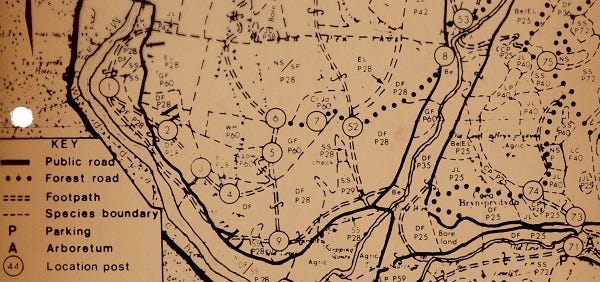
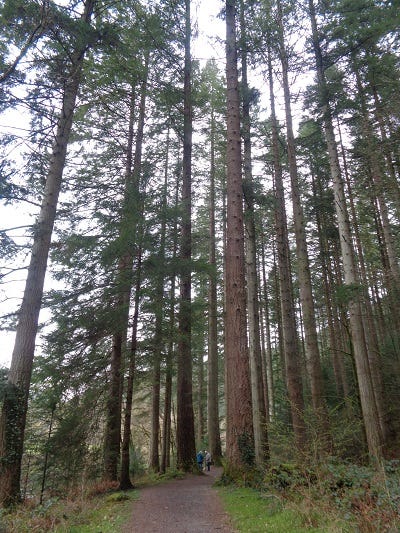

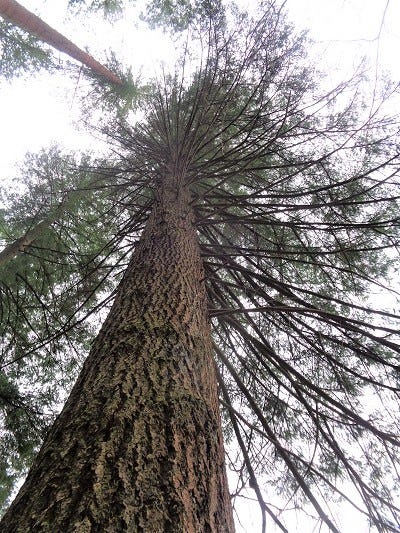
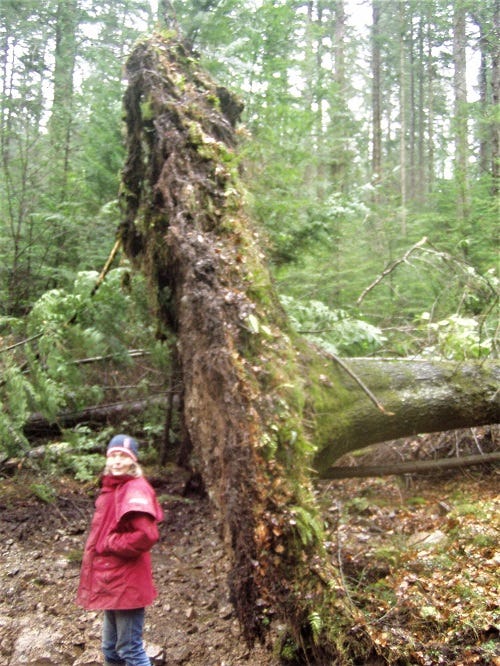
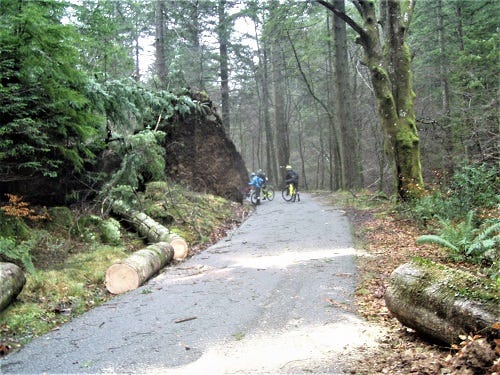
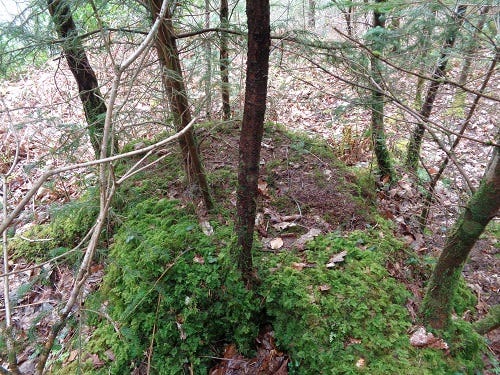
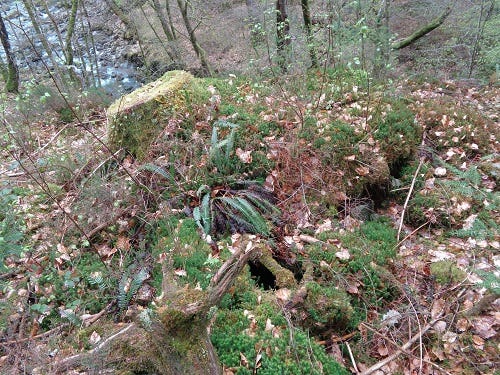

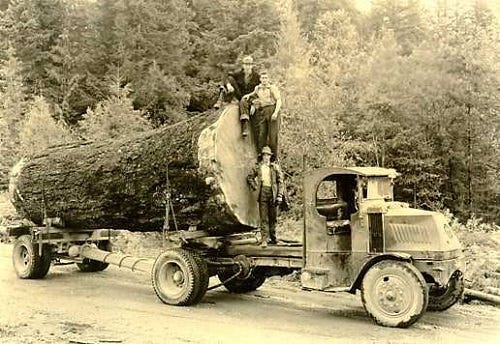
Interesting read. I would note that the fast rate of growth in the Coed y Brenin makes for a much less durable timber than Douglas grown in its native environment, which has growth rings about 3mm apart rather than 3cm. It seems particularly susceptible to rot caused by damp conditions: especially it dislikes being in contact with the ground. I would hazard a guess that Larch species that grow as large and as quickly would be a better bet for construction, being almost as strong mechanically, and rather more durable.
Incidentally, I can vouch for the dangers of cutting windfalls, the stumps crash back into place suddenly and with frightening force. I count myself lucky to have survived one such experience.
Here in the south of Portugal it would also be oak - rotundifolia and suber, olive, eucalyptus is a commonly grown exotic, white poplar, pinus pinea is the only conifer I'm sure of, grevillea robusta and paulownia are seen in towns and could be more widely utilised in the right situation. The grevillea's common name is silky oak because the timber is similar, or so I'm told. I have seed but imagine it'll be a while before I find out for myself. The limiting factors here are water and degraded soils, with little to no topsoil on hillsides. Coupled with the fire anxiety which leads to "cleaning the land" by discing at the beginning of summer, it's hard to find soil with organic matter, which of course, exacerbates the water shortage situation. We likely won't get rain again now until October, September if we are very lucky. It's very different to what I'm used to, small off grid farm near Oxford, but I'm sharing my kitchen with lizards and I couldn't be happier. I've been reading your old posts and I see we share the same interests. Very much enjoying reading them.